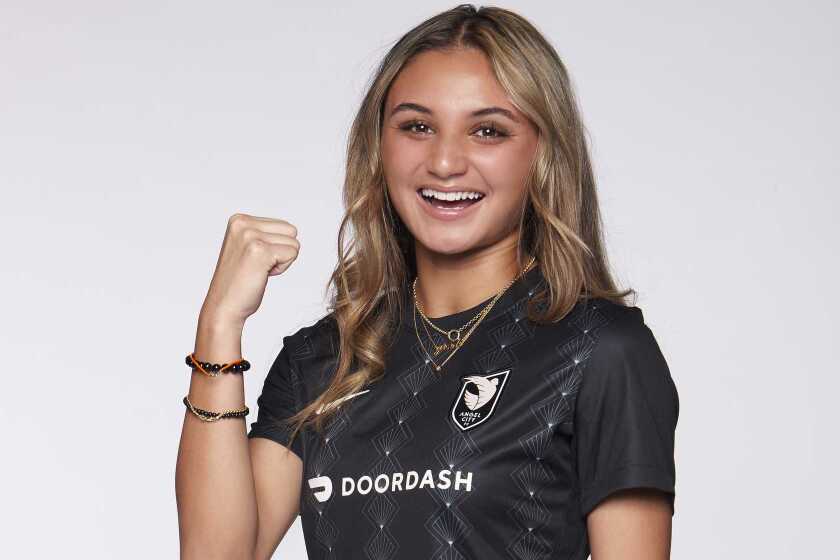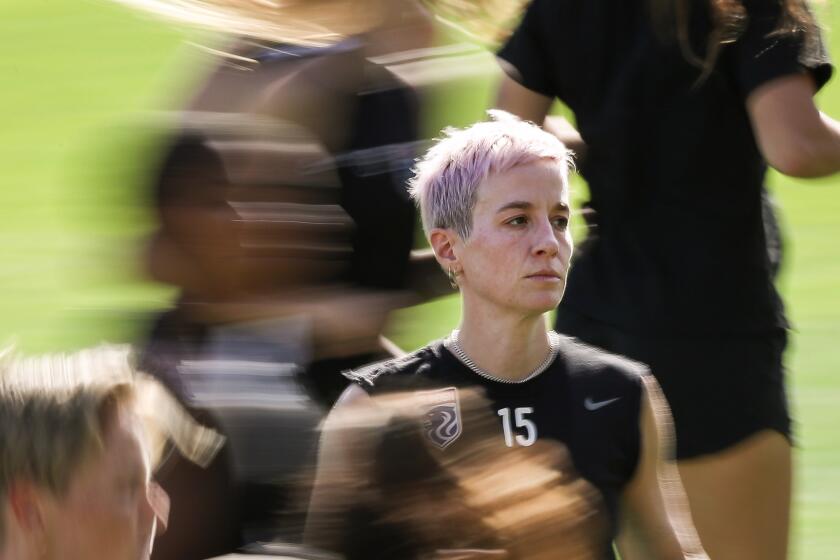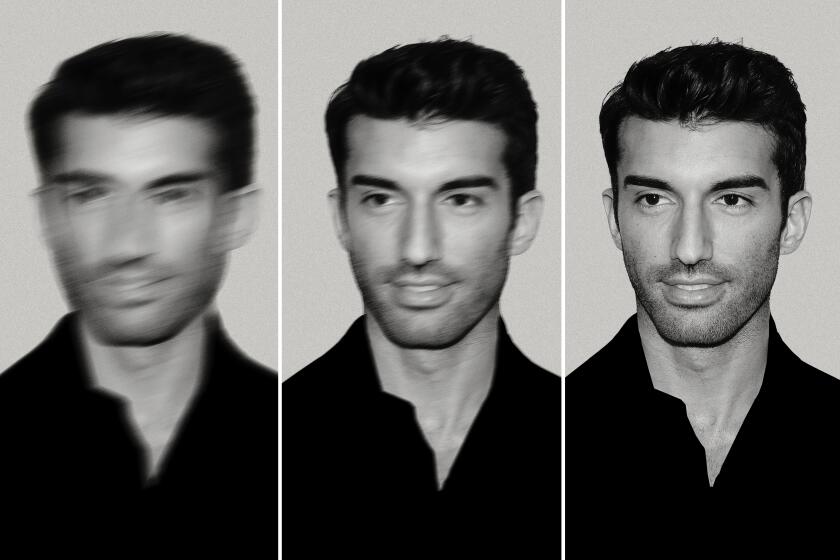Kevin Baxter writes about soccer and hockey for the Los Angeles Times. He has covered seven World Cups, five Olympic Games, six World Series and a Super Bowl and has contributed to three Pulitzer Prize-winning series at The Times and Miami Herald. An essay he wrote in fifth grade was voted best in the class. He has a cool dog.
- Share via
1
Takumi Jeannin remembers a time, not so long ago, when being an agent for women’s soccer players was a little like being a telemarketer. No one would take his calls and no one wanted to pay for what he was selling.
“It was crazy. We had to almost harass some clubs,” said Jeannin, an agent with A&V Sports Group. “I would send them like 10 emails hoping to get one answer. We had to chase much more to get people interested in what our players had to offer.”
Those days are long gone.
In the past 11 months alone Jeannin, working with just one club and representing teenagers who sleep in the same bedroom, has negotiated two contracts worth more than $1.6 million combined. The most recent came less than two weeks ago when Gisele Thompson, a senior at Harvard-Westlake, agreed to a three-year contract to join her sister Alyssa at Angel City.
Less than a year after signing Studio City teenager Alyssa Thompson, Angel City FC signs Thompson’s sister, Giselle, to a three-year contract.
“Now we are in a position where clubs call us, players contact us,” Jeannin said.
“The top salaries in the world are exploding,” he continued. “The NWSL is a good indicator of the growth worldwide. When we started, the minimum salary was $15,000. Next year, it will be $37,000. That’s a growth that you can see worldwide.”
A little more than a decade ago, Lucy Bronze had to work nights at a Domino’s and sleep on a friend’s sofa to make ends meet while playing for Everton in the Women’s Super League. Today Bronze, a four-time Champions League winner, a three-time World Cup semifinalist and a European champion, can not only buy her own pizza, she could buy shares in her own restaurant after signing a two-year deal with Barcelona that will pay her a reported $500,000.
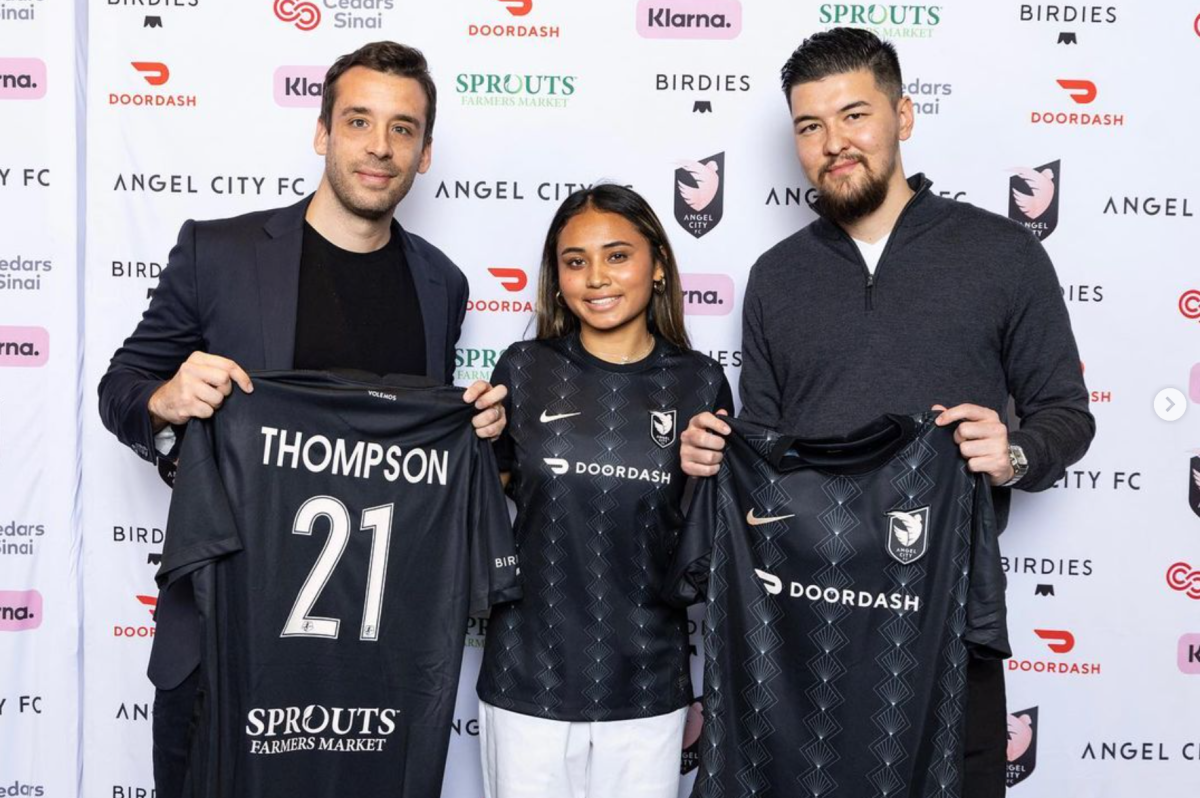
A&V Sports Group founder Alan Naigeon, left, stands next to Alyssa Thompson and her agent, Takumi Jeannin following her signing with Angel City FC in January 2023.
(Courtesy of Takumi Jeannin)
“At the time there was no real investment from the top clubs. If you did the bare minimum, it was enough to win,” Jeannin said of the women’s soccer landscape just a few years ago. “Real Madrid didn’t have a woman section three years ago. Now they do. So it forces Atlético Madrid, Barcelona to invest more just to be competitive.”
And the players are beginning to reap the rewards. Leah Williamson, captain of the English national team, earns more than a quarter-million dollars a year at Arsenal while Chelsea’s Sam Kerr, an A&V client, is among a handful of European players reportingly making more than twice Williamson’s salary. While that’s chump change for top men’s players, it’s a massive step forward in women’s soccer, where the jump in salaries has been fueled by widespread popularity for the game and its players.
According to FIFA, nearly 2 million people attended last summer’s World Cup in Australia/New Zealand, an average of 30,911 per game. Another 2 billion watched at least part of the tournament on TV, FIFA said. On the club level, Barcelona played to two crowds larger than 91,500 last year.
NWSL is booming, with attendance up 32%, Fortune 500 companies signing on as sponsors, team expansion and a historic new broadcast deal.
Sponsors and broadcasters have taken note. Last month, the NWSL announced a four-year, $240-million broadcast deal with CBS, Amazon, ESPN and Scripps worth 40 times the value of its old media rights contract. Sponsorship revenue in England’s Women’s Super League is estimated at $65 million for 2023-24 and the league has 31 media-rights deals, 29 of them international.
Closer to home, Angel City, a second-year NWSL team, was recently valued at a record $180 million with annual revenue of $31 million, according to the data-crunching website Sportico.
It all started, Jeannin said, with the players. When they raised the level of play, it made the game easier to sell to sponsors desperate for a way to support women’s sports and attract female customers.
“In my opinion, it’s the product on the field that grew first,” he said. “I see a big increase in terms of pure soccer compared to six, seven years ago. The players are better, tactically more sound, technically better. In France and Spain, they’ve started proper academies.
“You’re starting to see the reward of that. When the players are good, it makes you want to watch them. It’s a snowball effect.”
A&V Sports Group, a full-service boutique firm founded in 2011 largely to find foreign players homes with U.S. college programs, began representing women’s professional players just as the boom was building, cutting its first deal in 2017 when it helped Kadeisha Buchanan go from Western Virginia University to French giant Lyon. In six years, its client list has grown to include U.S. international Catarina Macario as well as 50 women from 20 countries who played in last summer’s World Cup, among them Kerr, Ballon d’Or winner Ada Hegerberg of Norway and Olympic champion Jessie Fleming of Canada.
LAFC looked like one of the best teams in MLS during part of the 2023 season, but the front office faces challenges keeping the team together.
The agency, founded by Alan Naigeon and Victor Bernard, has no male players. And Jeannin, 28, who quickly rose from intern to full partner after a playing career at the University of Mobile and UNLV that was arranged by the agency, has developed a special skill representing teenagers such as the Thompson sisters, who required special attention.
Both girls had a semester of high school to finish when they signed, for example, and both turned down scholarships at Stanford to go pro. So Jeannin had to make sure their contracts took their educational and family needs into account.
“When dealing with this type of player, we are dealing with much more than a soccer player,” he said. “So we have to be empathetic, understanding of what’s going on in her life and look at the much bigger picture than just the best club and sponsors.”
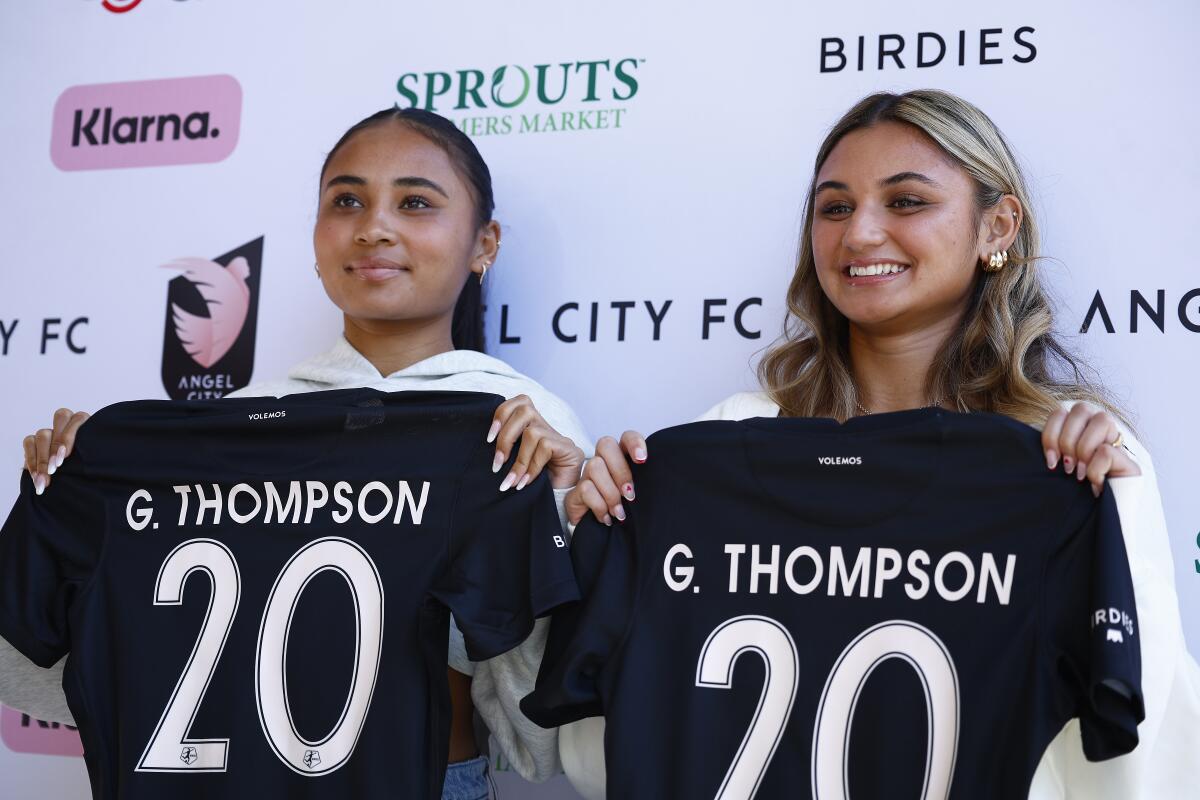
Alyssa Thompson, left, and Gisele Thompson hold up Angel City jerseys at the news conference announcing Gisele’s signing with the team.
(Ronald Martinez / Getty Images)
He also has to make sure his players are paid what they’re worth. In Alyssa’s case, that was $1 million over three years while Gisele’s contract has a base salary of $525,000 over three years and guaranteed bonuses and stipends worth $125,000 more.
“Our job is to provide the best opportunities for the player. And now the opportunities are there,” Jeannin said. “Angel City made it very attractive for her to sign here, not only financially but in providing an environment where she could stay at home, stay in her current high school and all that.
“So when you put it all together, it was the right fit.”
It came at the right price too, something Jeannin couldn’t have said just a few years ago.
⚽ You have read the latest installment of On Soccer with Kevin Baxter. The weekly column takes you behind the scenes and shines a spotlight on unique stories. Listen to Baxter on this week’s episode of the Corner of the Galaxy podcast.


